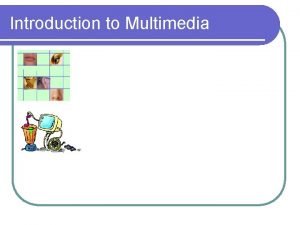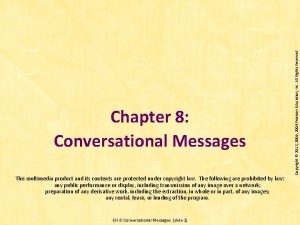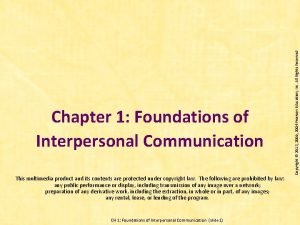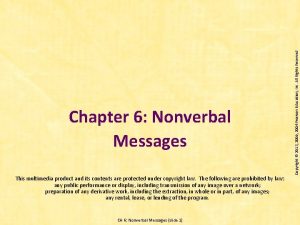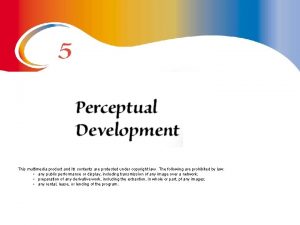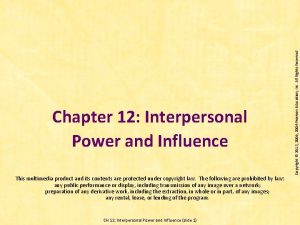This multimedia product and its contents are protected


























- Slides: 26

This multimedia product and its contents are protected under copyright law. The following are prohibited by law: any public performance or display, including transmission of any image over a network; preparation of any derivative work, including the extraction, in whole or in part, of any images; any rental, lease, or lending of the program. CH 4: Listening in Interpersonal Communication (slide 1) Copyright © 2013, 2009, 2006 Pearson Education, Inc. All Rights Reserved Chapter 4: Listening in Interpersonal Communication

§ Professional benefits § Personal benefits § § § Learn Relate Influence Play Help CH 4: Listening in Interpersonal Communication (slide 2) Copyright © 2013, 2009, 2006 Pearson Education, Inc. All Rights Reserved The Importance of Listening

§ Listening is a five stage process; the stages overlap and are performed simultaneously § Listening is never perfect § Listening is a skill that can be improved § Listening is not the same thing as hearing CH 4: Listening in Interpersonal Communication (slide 3) Copyright © 2013, 2009, 2006 Pearson Education, Inc. All Rights Reserved The Process of Listening

Stage 1: Receiving – the physiological, passive process of hearing vibrations around you. Ways to improve receiving 1. Focus your attention 2. Avoid distractions 3. Maintain your role as listener CH 4: Listening in Interpersonal Communication (slide 4) Copyright © 2013, 2009, 2006 Pearson Education, Inc. All Rights Reserved The Process of Listening (cont. )

Stage 1: Receiving Disclaimers – statements you make to listeners so your message won’t be interpreted negatively 1. Hedging 2. Credentialing 3. Sin licenses 4. Cognitive disclaimers 5. Appeals for suspension of judgment CH 4: Listening in Interpersonal Communication (slide 5) Copyright © 2013, 2009, 2006 Pearson Education, Inc. All Rights Reserved The Process of Listening (cont. )

Stage 2: Understanding - you learn what the speaker’s thoughts and emotions mean Ways to improve understanding 1. Avoid assuming you understand 2. See the speaker’s messages from the speaker’s point of view 3. Ask questions for clarification 4. Rephrase or paraphrase CH 4: Listening in Interpersonal Communication (slide 6) Copyright © 2013, 2009, 2006 Pearson Education, Inc. All Rights Reserved The Process of Listening (cont. )

Stage 3: Remembering § You remember not what was said, but what you remember was said § Memory is reconstructive, not reproductive § Short term memory § Long term memory CH 4: Listening in Interpersonal Communication (slide 7) Copyright © 2013, 2009, 2006 Pearson Education, Inc. All Rights Reserved The Process of Listening (cont. )

Stage 3: Remembering Ways to improve remembering 1. Focus your attention on central ideas 2. Organize material into categories or chunks 3. Relate new information to information you already know 4. Repeat key names or concepts to yourself CH 4: Listening in Interpersonal Communication (slide 8) Copyright © 2013, 2009, 2006 Pearson Education, Inc. All Rights Reserved The Process of Listening (cont. )

Stage 4: Evaluating – consciously or unconsciously judging the message Ways to make better critical judgments 1. Resist evaluating until you fully understand the speaker’s point of view 2. Separate facts from the speaker’s opinion or viewpoint CH 4: Listening in Interpersonal Communication (slide 9) Copyright © 2013, 2009, 2006 Pearson Education, Inc. All Rights Reserved The Process of Listening (cont. )

Stage 4: Evaluating Ways to make better critical judgments 3. Identify speaker’s bias, slant or self-interest 4. Recognize fallacies in reasoning § Name calling § Testimonial § Bandwagon CH 4: Listening in Interpersonal Communication (slide 10) Copyright © 2013, 2009, 2006 Pearson Education, Inc. All Rights Reserved The Process of Listening (cont. )

Stage 5: Responding – giving immediate or delayed feedback to the speaker on what you think and how you feel about the message Ways to improve responding 1. Support the speaker with listening cues 2. Take responsibility for what you say; use I-statements and avoid anonymity CH 4: Listening in Interpersonal Communication (slide 11) Copyright © 2013, 2009, 2006 Pearson Education, Inc. All Rights Reserved The Process of Listening (cont. )

Stage 4: Evaluating Ways to make better critical judgments 3. Resist responding to the speaker’s feelings by trying to solve their problems 4. Focus on the other person 5. Avoid being a “thought-completer” listener CH 4: Listening in Interpersonal Communication (slide 12) Copyright © 2013, 2009, 2006 Pearson Education, Inc. All Rights Reserved The Process of Listening (cont. )

1. Physical and mental distractions 2. Biases and prejudices 3. Lack of appropriate focus § Irrelevant details § Only what relates to you § Listen on in order to counter or reply 4. Premature judgment CH 4: Listening in Interpersonal Communication (slide 13) Copyright © 2013, 2009, 2006 Pearson Education, Inc. All Rights Reserved Listening Barriers

Three cultural differences influence listening 1. Language, meanings, and accents 2. Nonverbal behaviors Display rules – cultural rules that govern what nonverbal displays are appropriate 3. Is direct or indirect feedback more appropriate? CH 4: Listening in Interpersonal Communication (slide 14) Copyright © 2013, 2009, 2006 Pearson Education, Inc. All Rights Reserved Culture, Gender and Listening

Gender differences influence listening 1. Women listen to build rapport and relationships (rapport talk); men listen to build respect with knowledge and expertise (report talk) 2. Listening cues - women give obvious listening cues, men listen more quietly; women appear to listen more than men. CH 4: Listening in Interpersonal Communication (slide 15) Copyright © 2013, 2009, 2006 Pearson Education, Inc. All Rights Reserved Culture, Gender and Listening (cont. )

Gender differences influence listening 3. Amount and purpose § § § Men listen to women less than women listen to men Listening indicates subordinate status Men’s questions are argumentative and competitive, women’s are supportive Research is conflicting Gender roles are changing CH 4: Listening in Interpersonal Communication (slide 16) Copyright © 2013, 2009, 2006 Pearson Education, Inc. All Rights Reserved Culture, Gender and Listening (cont. )

1. Empathic and objective listening § Empathic listening – listen to feel the other’s feelings, fully understand the other’s meaning; usually the preferred mode of listening § Objective listening – measure someone’s feelings against objective reality CH 4: Listening in Interpersonal Communication (slide 17) Copyright © 2013, 2009, 2006 Pearson Education, Inc. All Rights Reserved Styles of Effective Listening

Adjusting your empathic and objective listening § § § Punctuate from the speaker’s point of view Engage in equal, two-way conversation Seek to understand both thought and feeling Avoid “offensive” listening Strive to be objective CH 4: Listening in Interpersonal Communication (slide 18) Copyright © 2013, 2009, 2006 Pearson Education, Inc. All Rights Reserved Styles of Effective Listening (cont. )

2. Nonjudgmental and critical listening § Nonjudgmental listening – listen with an open mind toward understanding § Critical listening – listening to analyze and evaluate messages CH 4: Listening in Interpersonal Communication (slide 19) Copyright © 2013, 2009, 2006 Pearson Education, Inc. All Rights Reserved Styles of Effective Listening (cont. )

Adjusting your nonjudgmental and critical listening: § Keep an open mind avoid prejudging § Avoid filtering out and oversimplifying complex messages § Recognize your own biases; watch for assimilation § Avoid sharpening § Recognize the fallacies of language CH 4: Listening in Interpersonal Communication (slide 20) Copyright © 2013, 2009, 2006 Pearson Education, Inc. All Rights Reserved Styles of Effective Listening (cont. )

3. Surface and depth listening § Surface listening – listening to the literal meaning of words and sentences § Depth listening – listening to underlying message about the person’s feelings and needs CH 4: Listening in Interpersonal Communication (slide 21) Copyright © 2013, 2009, 2006 Pearson Education, Inc. All Rights Reserved Styles of Effective Listening (cont. )

3. Surface and depth listening (cont. ) Regulating your nonjudgmental and critical listening: § Focus on both verbal and nonverbal messages § Listen for both content and relational messages § Make special note of self-referential statements – statements referring back to speaker § Don’t disregard surface or literal meaning CH 4: Listening in Interpersonal Communication (slide 22) Copyright © 2013, 2009, 2006 Pearson Education, Inc. All Rights Reserved Styles of Effective Listening (cont. )

4. Polite and impolite listening § § § Avoid interrupting the speaker Give supportive listening cues Show empathy with the speaker Maintain eye contact Give positive feedback CH 4: Listening in Interpersonal Communication (slide 23) Copyright © 2013, 2009, 2006 Pearson Education, Inc. All Rights Reserved Styles of Effective Listening (cont. )

5. Active listening - sending back to speaker what you think he or she meant in both content and feelings § Check your understanding of what speaker said and meant § Let speaker know you acknowledge and accept their feelings and § Helps speaker further explore their thoughts and feelings CH 4: Listening in Interpersonal Communication (slide 24) Copyright © 2013, 2009, 2006 Pearson Education, Inc. All Rights Reserved Styles of Effective Listening (cont. )

Avoid solution messages in active listening § § Ordering messages Warning and threatening messages Preaching and moralizing messages Advising messages CH 4: Listening in Interpersonal Communication (slide 25) Copyright © 2013, 2009, 2006 Pearson Education, Inc. All Rights Reserved Styles of Effective Listening (cont. )

Techniques of active listening a. Paraphrase speaker’s meaning b. Express understanding of speaker’s feelings c. Ask questions CH 4: Listening in Interpersonal Communication (slide 26) Copyright © 2013, 2009, 2006 Pearson Education, Inc. All Rights Reserved Styles of Effective Listening (cont. )
 Antigentest åre
Antigentest åre Linear and nonlinear in multimedia
Linear and nonlinear in multimedia Multimedia becomes interactive multimedia when
Multimedia becomes interactive multimedia when Csc253
Csc253 Esa multimedia.esa.int./multimedia/virtual-tour-iss
Esa multimedia.esa.int./multimedia/virtual-tour-iss Difference between real mode and virtual mode of 80386
Difference between real mode and virtual mode of 80386 The kidneys are protected by the ribs and a cushion of fat
The kidneys are protected by the ribs and a cushion of fat Protected objects and methods of protection
Protected objects and methods of protection Key quotes in the emigree
Key quotes in the emigree Its halloween its halloween the moon is full and bright
Its halloween its halloween the moon is full and bright Multi media product
Multi media product Multimedia product
Multimedia product Interactive multimedia products r087
Interactive multimedia products r087 What is a multimedia product
What is a multimedia product New product development and product life cycle strategies
New product development and product life cycle strategies Average product of labor
Average product of labor Product line width
Product line width Chapter 3 feasibility study
Chapter 3 feasibility study Gnp gdp meaning
Gnp gdp meaning Federally protected classes
Federally protected classes Protected in uml
Protected in uml Walmart pto payout
Walmart pto payout Protected mode memory addressing
Protected mode memory addressing Scope of protected cultivation
Scope of protected cultivation Emergent high level wellness
Emergent high level wellness Federally protected classes
Federally protected classes Federally protected classes
Federally protected classes










